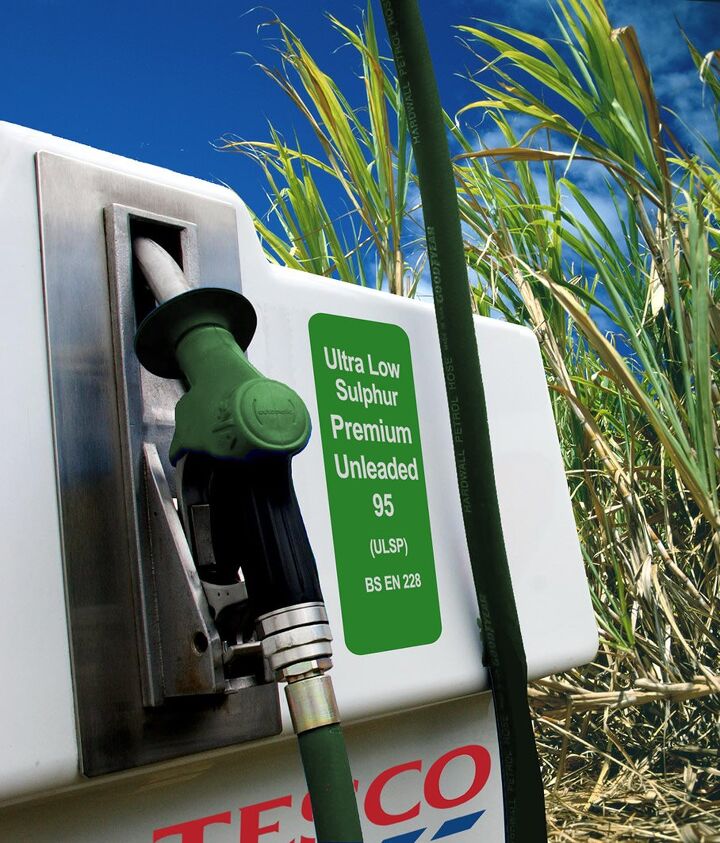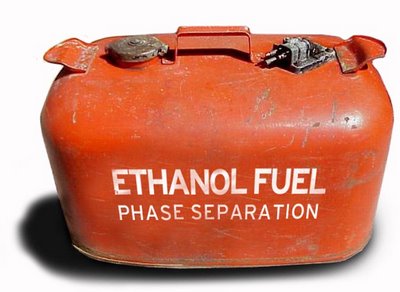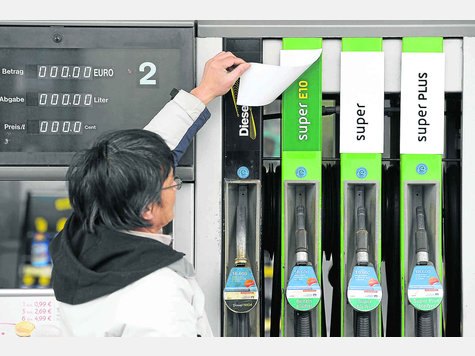#Ethanol
Brazilian Cars High on American Alcohol
Around two thirds of the oil used in the United States is imported. Now, something is done to offset this energy trade imbalance ever so slightly: Ethanol, the stuff that is supposed to save the U.S. from foreign oil dependency is shipped out of the country.
Who buys it? Brazil, the land where cars drink alcohol to drive.
Wonders Loom: The Greening Of NASCAR
The rot-gut whiskey powered good ol’ boys who turned their fleet flite from revenooers into stock car racing must be flipping their ‘40 Fords in their graves. Nah, on second thought, they’d be so proud that their Prohibition-defying race car culture has swept the nation they’d be bemused by the news. Nascar is going effete… uh, green.
Where Are Our Green Car Priorities?
As a relatively pragmatic person who generally chooses the imperfect-yet-achievable path rather than agonizing over the perfect-but-unattainable goal, this chart [from a fascinating Boston Consulting report, in PDF here] frustrates me. I understand why Americans choose hybrid-electric cars as their most favored “green car” technology, but from their it gets fairly crazy. EVs are fantastic on paper, but in the real world they’re still far too expensive, their batteries degrade, they have limited range, oh and did I mention that they’re freaking expensive? Biofuels, America’s third-favorite “green” transportation technology can be fantastic in certain limited applications, but the ongoing ethanol boondoggle proves that it will never be a true “gasoline alternative.” Finally, at the bottom of the list, Americans grudgingly accept only relatively slight interest in the two most promising short-term technologies: diesel and CNG. Neither of these choices is radically more expensive than, say, a hybrid drivetrain and both are considerably less expensive and compromised than EVs at this point. So why are we so dismissive of them?
United Nations: This Is Your Car On Ethanol
A chicken could become as unreachable as caviar in many poor countries, warns a study of the OECD and the United Nations. Chicken is projected to rise in price by 30 percent in the next ten years – inflation adjusted. Other staple foods such as corn, sugar or cooking oil are seen rising in price by twenty percent. Why? On one side of the ledger is higher demand, mainly from China and India. On the other side: „Increasingly, the crop doesn’t end up in the pot, but as fuel in the tanks of cars,“ says the German magazine Der Spiegel.
Senate Votes To Repeal Ethanol Tax Credits
Cracks continued to in the ethanol industry’s once-impregnable political vanguard, as the San Francisco Chronicle reports that the Senate has voted to roll back the Volumetric Ethanol Excise Tax Credit (VEETC) as well as import tariffs on foreign-produced ethanol. This rollback of multi-billion-dollar ethanol credits failed earlier in the week, when the Detroit News reports automakers came out in opposition of a bill that would have required that 95% of all cars built in the US be capable of running 85% ethanol by 2017. The Senate did fail to pass a repeal of a government ethanol blending mandate that underpins the VEETC, however, and funding is moving forward for ethanol blending pumps. Still, the Senate’s repeal of VEETC alone means taxpayers could save over $5b per year on subsidies, and as one expert puts it
“Looks like we’re going to be relying on the biofuels mandates to make sure blenders use biofuels, rather than bribing them to use it with $6 billion,” [Bruce Babcock, professor of economics and the director of the Center for Agricultural and Rural Development at Iowa State University] said.
In fact, Babcock thinks killing the subsidy could help ethanol because it would come out from the stigma of being a subsidized industry. And removing the subsidy may strengthen support for the mandate, and the tariff on imports.
Over to you, House of Representatives…
What's Wrong With This Picture: E15 Ethanol Is Coming Edition
Reuters reports that White House has approved a label for E15 ethanol blends, which warn motorists not to use the higher blend if their vehicle was built before the 2007 model-year. What Reuters won’t show you is the final label design that was approved… was it the EPA’s proposed design (above), or one of the ethanol lobby’s proposed alternatives (see gallery below). Clearly there’s a bit of a difference between the two, and the EPA was under quite a bit of pressure to not go with the orange-and-red “CAUTION!” version. In documentation from hearings on the E15 labeling issue [ PDF], you can read executives and lobbyists expounding at length about the fact that ethanol is good for America, and that labeling shouldn’t discourage the use of E15. Which it doesn’t…. in 2007 and later vehicles. And if you check the EPA’s docket on the issue, you’ll find plenty of good reasons for preventing “misfueling”. Luckily few gas station owners are likely to invest in E15 pumps anyway, so you may never actually see this label in the wild.
Quote Of The Day: The Beginning Of The End Of Ethanol Edition
Over the course of TTAC’s coverage of US ethanol subsidies, I’ve often wondered why nobody made a political issue out of slaying an ever-growing waste of tax dollars ($6b this year on the “blender’s credit” alone). And with the political rhetoric about America’s debt prices rising, I’ve been wondering with more and more regularity when someone will finally take the ethanol fight to the American people, who are already voting against ethanol with their pocketbooks. But just last December, Al Gore explained why not even he, an environmentalist standard-bearer, could oppose the corn juice he knew was bad policy, saying
It is not a good policy to have these massive subsidies for first generation ethanol. First generation ethanol I think was a mistake. The energy conversion ratios are at best very small… One of the reasons I made that mistake is that I paid particular attention to the farmers in my home state of Tennessee, and I had a certain fondness for the farmers in the state of Iowa because I was about to run for president.
The Iowa primary is a key early contest in the Presidential election, and because Iowans grow and refine a huge amount of corn ethanol, campaigning against ethanol subsidies in Iowa is a non-starter. At least that’s what the conventional wisdom was before today, when, with nearly nine months to go before the primary, the impossible just happened.
Ethanol In Germany: Education Is Not The Answer
TTAC has paid close attention to the fortunes of ethanol in the United States, where grossly wasteful subsidies have forced the corn-derived fuel into the fuel supply in growing percentages, drawing backlash from small but vocal portions of the population. But much of the ethanol ire is directed at higher blends like the recently-approved E15 and the increasingly-unpopular E85 mixtures. Meanwhile, most Americans regularly fill up their tanks with E10, which has become standard at pumps across the nation. But in Germany, where E10 was only just introduced, people are rejecting the low-ethanol blend that even the most vocal American ethanol opponents use every day. Initially, the biofuel industry in Germany blamed a lack of education for suspicion of E10, but according to Autobild, some 75 percent of German drivers now know whether their vehicle takes E10 (and most do)… but still, only 17 percent actually chose E10 for their last fill-up. And only 39 percent who know for a fact that their car can take E10 have ever used the ten-percent ethanol fuel. Why? Despite the high level of education, 52 percent of respondents still feared motor damage from the ethanol. Another 50 are opposed to “filling up with food.” Sometimes the more you know about something, the less you like it.
Bipartisan Bill Seeks To End Cornerstone Ethanol Subsidy
Yesterday evening I directed some ire at President Obama’s continued reliance on ethanol as a major plank of his do-nothing transportation/energy agenda, noting
That extra money for 10,000 E15-capable pumps? That’s because no gas station owner will pay to install a pump for a kind of fuel that only cars built since 2001 can use… and which the auto industry has tried to ban. And why E15 in the first place? Because blenders can’t sell enough E10 to blend the government-mandated amount of ethanol and collect their $6b this year in “blender’s credits” to do so. A subsidy to support a subsidy which in turn props up yet another subsidy (I may have missed a subsidy in there somewhere). You can’t make this stuff up.
The “cornerstone” subsidy that all other ethanol subsidies support is the Volumetric Ethanol Excise Tax Credit, or VEETC, or “blender’s credit,” a $6b per year subsidy that directs 45 cents to refiners for every gallon of ethanol they blend with gasoline. The VEETC nearly died in December’s lame duck session, only to be revived as a way to buy votes for the President’s tax policy. Now, however, The State Column reports that a bipartisan Senate bill has been introduced that would eliminate both the VEETC and import tariffs on foreign-made ethanol. And with a rash of bad news coming out about ethanol, this could just be the opportunity to kill this wasteful government subsidy with fire.
What's Wrong With This Picture: Fixing Transportation Edition
President Obama devoted his weekly address to energy and transportation policy this week, speaking to the nation from an Allison hybrid bus transmission plant in Indiana. A White House blog post accompanying video of the President’s speech included a large infographic on “The Obama Energy Agenda And Gas Prices,” the transportation-oriented section I’ve excerpted above. This one section is actually a fairly good representation of Obama’s auto-related energy policy preferences, and illustrates why I often find myself criticizing the president here at TTAC.
GAO: Government Ethanol Rules Actually Increase Gasoline Use
A massive study by the Government Accountability Office into “Opportunities to Reduce Potential Duplication in Government Programs, Save Tax Dollars, and Enhance Revenue” has turned up an interesting finding. It seems that the government’s desire to buy more “alternative fuel vehicles” (AFVs) may actually increase the amount of gasoline used by government fleets. Why? Because agencies largely buy E85 ethanol-powered vehicles to fulfill their AFV requirements, and there aren’t enough E85 pumps to actually fuel the fleet, forcing agencies to obtain waivers to buy regular gasoline. Hit the jump for the report’s full findings on this, the latest unintended consequence of America’s ongoing ethanol-subsidy boondoggle.
New Ethanol Bill Faces Automaker Resistance
How things change in a few years! Just a few short orbits of the sun ago, automakers like GM were some of the biggest boosters of ethanol subsidies. Now, the Detroit News reports
The Alliance of Automobile Manufacturers – the trade association representing General Motors Co., Ford Motor Co., Chrysler Group LLC, Toyota Motor Corp. and eight others – opposes a bill sponsored by Sen. Tom Harkin, D-Iowa, that would require 90 percent of all vehicles to run on E85 – a blend of 85 percent ethanol – by the 2016 model year.
Shane Karr, vice president for government affairs, said the mandate “would cost consumers more than $2 billion per year” for flex fuel vehicles if automakers passed on the full cost “even though consumers will have little or no access to alternative fuels. Therefore, such a mandate is essentially a tax with little consumer benefit.”
In the face of this new opposition, the Renewable Fuels Association has even taken to employing the rhetoric of market economics to justify market-manipulating ethanol subsidies. And it doesn’t seem to be convincing anyone. If anything, Harkin’s bill may just hasten the death of existing subsidies, which are under pressure as both Democrats and Republicans seek to trim the federal budget.
Ethanol "Blender Credit" Under Attack Again
At the end of last year, the Volumetric Ethanol Excise Tax Credit (aka “Blender’s Credit) very nearly expired before congress passed a one-year, $6b extension to the subsidy. The near-collapse of the largest “renewable energy” subsidy on the federal books came as the backlash built against the EPA’s approval of E15 (15% ethanol) blends for certain vehicles, with a huge coalition of industries, environmentalists and budget hawks coalescing around the idea of ending government support for corn-based ethanol. That coalition lost some momentum as the VEETC was extended in order to drum up support for the controversial tax bill that was passed during December’s lame duck session. But now, SolveClimate [via Reuters] reports that the brewing deficit battles have put the Blender’s Credit back on the chopping block, as a new bill seeks to cut the wasteful, inefficient and unpopular (outside of farm states) subsidy.
Killer Ethanol Continues To Confuse German Car Owners
Germany is in an uproar against ethanol. Last week, motorists celebrated a win against alcohol in their gasoline: Oil companies stopped the build-out of E10 gas stations. The matter still fuels the headlines. Over the weekend, German’s Die Welt newspaper shocked its readers with the news that the bio-benzene can ruin engines which supposedly are ok for the fuel.
“E10 is under suspicion to stress the engine oil harder than conventional fuel. This causes minimized viscosity and increased engine wear,” writes the paper. Supposedly, the stuff literally waters down the oil. Die Welt quotes Thomas Brüner of BMW who said: “The 10 percent ethanol increase the water in the engine. The water condenses and mixes with the oil. The oil gets diluted and ages faster.”
German Buyer Strike Stops Ethanol
German motorists won an important battle against ethanol. They used a downright un-German tactic: Widespread insurrection. They simply won’t buy the stuff. An edict handed down from Brussels ordered that Super has to contain 10 percent of ethanol. An alliance from Germany’s ADAC autoclub to Greenpeace said the new gasoline is a work of the devil, it is liable to ruin cars, and the environment. That didn’t impress Brussels. But then, a buyer strike did set in.




















Recent Comments